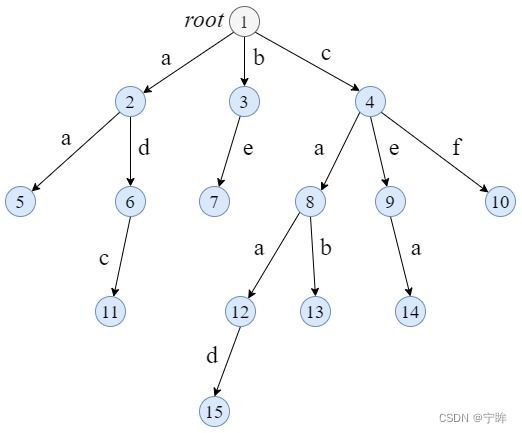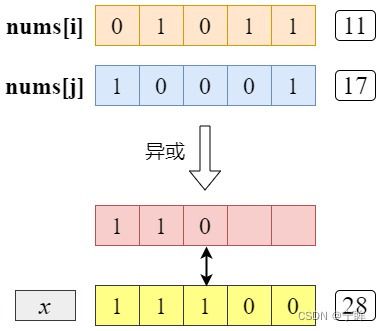字典树基础与应用
字典树(Trie)
字典树(Trie)也叫前缀树,是一种针对字符串进行维护的树。
-
其中的键通常是字符串,由节点在树中的位置决定,键保存在边而不是在节点
-
一个节点的所有子孙具有相同的前缀,也就是这个节点代表的字符串,根节点代表空字符串
下图中,1 - 4 - 8 - 13有3条边,表示字符串cab
初始化根节点
- 假设字典中只有26个小写字母,则每个节点至多有26个子节点
is_end表示当前字符串是否在这里截止,False代表前缀,True代表末尾
class Trie:
def __init__(self):
self.children = [None] * 26
self.is_end = False
插入字符串
从字典树的根开始,向下查找字符串的插入位置,对于当前字符对应的子节点,有两种情况:
- 子节点存在,
node = node.children[ch],向下查找子节点 - 子节点不存在,创建一个新的节点,放在当前字符对应的位置上,再向下查找子节点
- 遍历完字符串
word,也就是到了word对应的最后一个节点,打上标记node.is_end = True
比如说在下面的字典树中插入字符串cat,
查找第一个字符c存在,继续向下,a也存在,继续向下,t不存在
于是在a的子节点下面,创建一个新节点t,至此,cat字符串就被插入到了字典树中
def insert(self, word: str) -> None:
node = self
for ch in word:
ch = ord(ch) - ord('a')
if not node.children[ch]:
node.children[ch] = Trie()
node = node.children[ch]
node.is_end = True
查询字符串
从字典树的根开始,向下查找字符串,对于当前字符对应的子节点,有两种情况:
- 子节点存在,
node = node.children[ch],向下查找子节点 - 子节点不存在,说明字典树中没有该前缀,返回
None - 根据前缀查找结果,判断最后节点是否是末尾节点,如果是,说明找到了该字符串;如果不是末尾节点,说明只找到了该字符串的前缀
def searchPrefix(self, prefix: str) -> "Trie":
node = self
for ch in prefix:
ch = ord(ch) - ord('a')
if not node.children[ch]:
return None
node = node.children[ch]
return node
def search(self, word: str) -> bool:
node = self.searchPrefix(word)
return node is not None and node.is_end
def startsWith(self, prefix: str) -> bool:
node = self.searchPrefix(prefix)
return node is not None
完整代码
对应Leetcode上的题目:208. 实现 Trie (前缀树) - 力扣(Leetcode)
class Trie:
def __init__(self):
self.children = [None] * 26
self.is_end = False
def insert(self, word: str) -> None:
node = self
for ch in word:
ch = ord(ch) - ord('a')
if not node.children[ch]:
node.children[ch] = Trie()
node = node.children[ch]
node.is_end = True
def searchPrefix(self, prefix: str) -> "Trie":
node = self
for ch in prefix:
ch = ord(ch) - ord('a')
if not node.children[ch]:
return None
node = node.children[ch]
return node
def search(self, word: str) -> bool:
node = self.searchPrefix(word)
return node is not None and node.is_end
def startsWith(self, prefix: str) -> bool:
node = self.searchPrefix(prefix)
return node is not None
字典树的应用
1803. 统计异或值在范围内的数对有多少 - 力扣(Leetcode)
给你一个整数数组 nums (下标 从 0 开始 计数)以及两个整数:low 和 high ,请返回 漂亮数对 的数目。
漂亮数对 是一个形如 (i, j) 的数对,其中 0 <= i < j < nums.length 且 low <= (nums[i] XOR nums[j]) <= high 。
- 1 < = n u m s . l e n g t h < = 2 ∗ 1 0 4 1 <= nums.length <= 2 * 10^4 1<=nums.length<=2∗104
- 1 < = n u m s [ i ] < = 2 ∗ 1 0 4 1 <= nums[i] <= 2 * 10^4 1<=nums[i]<=2∗104
- 1 < = l o w < = h i g h < = 2 ∗ 1 0 4 1 <= low <= high <= 2 * 10^4 1<=low<=high<=2∗104
题目求解异或结果在 [low, high]之间的数对个数,可以转换为求解异或结果在(0, high]和(0, low)的个数之差
用 f ( x ) f(x) f(x)表示数组中异或结果小于x的数对个数,问题转换为求解 f ( h i g h + 1 ) − f ( l o w ) f(high+1)-f(low) f(high+1)−f(low)
看到这题第一个想到的是暴力遍历nums,两两取异或,根据异或结果计数,这是我第一次写的代码,毫无疑问超时了
class Solution:
def countPairs(self, nums: List[int], low: int, high: int) -> int:
n = len(nums)
ans = 0
for i in range(n-1):
for j in range(i+1, n):
if low <= nums[i] ^ nums[j] <= high:
ans += 1
return ans
怎么在这题使用字典树呢?
自己用笔写一下,我们比较nums[i]^nums[j]与x的结果时,怎么比较最快?答案是将nums[i]、nums[j]和x都转换为二进制,为了表示方便,将nums[i],nums[j],x写作a,b,c,分别转为二进制数 a i a i − 1 . . . a 2 a 1 , b i b i − 1 . . . b 2 b 1 , c i c i − 1 . . . c 2 c 1 a_ia_{i-1}...a_2a_1,b_ib_{i-1}...b_2b_1,c_ic_{i-1}...c_2c_1 aiai−1...a2a1,bibi−1...b2b1,cici−1...c2c1,我们从高位往低位比较,当找到一个 j ( j < = i ) j(j<=i) j(j<=i),满足 a j a_j aj^ b j b_j bj< c j c_j cj时,就不会继续往下比较了,因为不管后面是什么结果,a异或b的结果都会比c小。
上面讲的比较抽象,下面用画图举例说明,nums[i]=11,nums[j]=17,x=28
从左往右比较,当比较到第3位时,异或结果是比x小的,所以后面就不用比较了。
鉴于这一特性,我们可以把nums转为前缀表(字典树),将nums中的元素看作二进制表示的字符串
- 字符串只包含0和1
- 由于 1 < = n u m s [ i ] < = 2 ∗ 1 0 4 1 <= nums[i] <= 2 * 10^4 1<=nums[i]<=2∗104,而 2 ∗ 1 0 4 < 2 15 2 * 10^4 < 2^{15} 2∗104<215,因此字符串的长度是15(高位补零就好)
初始化
每个节点除了包含两个子节点外,还有一个cnt属性,表示根结点到该节点路径为前缀的字符串个数。
class Trie:
def __init__(self):
self.children = [None] * 2
self.cnt = 0
插入字符串
从字典树的根开始,向下查找字符串的插入位置,对于当前字符对应的子节点,有两种情况:
- 子节点存在,
node = node.children[ch],向下查找子节点 - 子节点不存在,创建一个新的节点,放在当前字符对应的位置上,再向下查找子节点
每遍历一个节点,不管节点是否存在,节点的cnt都要加1
def insert(self, word):
node = self
for i in range(15, -1, -1):
# 从高位取数字
flag = word >> i & 1
if not node.children[flag]:
node.children[flag] = Trie()
node = node.children[flag]
node.cnt += 1
查询字符串
从字典树的根开始遍历,向下查找字符串的插入位置,并记录满足条件的前缀数量
- 子节点不存在,说明字符串这条路径到了末尾,返回累加的前缀数量
- x是基准值,子节点存在时有两种情况:
- 如果
x的当前位为1,就加上异或结果为0的子节点的前缀数量(小于),然后走向异或结果为1的子节点node = node.children[flag ^ 1] - 如果
x的当前位为0,就要走向异或结果为0的子节点node = node.children[flag] - 注意,
flag ^ 1 ^ flag = 1,flag ^ flag=0
- 如果
比如在下面的字典树中查询17的异或结果,基准值为28,答案为5

def search(self, a, x):
node = self
ans = 0
for i in range(15, -1, -1):
if not node:
return ans
# 基准数x的第i位数字
y = x >> i & 1
# 查询数a的第i位数字
flag = a >> i & 1
if y == 1:
# 只有当异或结果可能为0时,才记录cnt
if node.children[flag]:
ans += node.children[flag].cnt
node = node.children[flag ^ 1]
else:
node = node.children[flag]
return ans
为防止重复比较,将nums中的元素依次放入字典树,每查询一个,放入一个。
class Solution:
def countPairs(self, nums: List[int], low: int, high: int) -> int:
ans = 0
tree = Trie()
for x in nums:
ans += tree.search(x, high + 1) - tree.search(x, low)
tree.insert(x)
return ans
完整代码:
class Trie:
def __init__(self):
self.children = [None] * 2
self.cnt = 0
def insert(self, word):
node = self
for i in range(15, -1, -1):
flag = word >> i & 1
if not node.children[flag]:
node.children[flag] = Trie()
node = node.children[flag]
node.cnt += 1
def search(self, a, x):
node = self
ans = 0
for i in range(15, -1, -1):
if not node:
return ans
# 基准数x的第i位数字
y = x >> i & 1
# 查询数a的第i位数字
flag = a >> i & 1
if y == 1:
# 只有当异或结果可能为0时,才记录cnt
if node.children[flag]:
ans += node.children[flag].cnt
node = node.children[flag ^ 1]
else:
node = node.children[flag]
return ans
class Solution:
def countPairs(self, nums: List[int], low: int, high: int) -> int:
ans = 0
tree = Trie()
for x in nums:
ans += tree.search(x, high + 1) - tree.search(x, low)
tree.insert(x)
return ans




